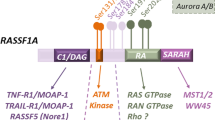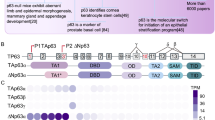Abstract
Proliferation of epithelial cells must be spatiotemporally regulated to maintain the organization of epithelial sheets. Here we show that the IQGAP family, comprising IQGAP1, 2 and 3, underlies lateral cell–cell contacts of epithelial cells. Of the three proteins, IQGAP3 is unique in that its expression is specifically confined to proliferating cells. Knockdown of IQGAP3 in cultured epithelial cells caused inhibition of proliferation and ERK activity. When exogenously expressed in quiescent cells, IQGAP3 was capable of inducing cell-cycle re-entry, which was completely inhibited by the MEK inhibitor U0126. Thus, IQGAP3 is necessary and sufficient for driving cell proliferation and ERK acts downstream of IQGAP3. Furthermore, IQGAP3 specifically interacted with the active, GTP-bound form of Ras, and in IQGAP3 knockdown cells, the activity of Ras, but not of other small GTPases, was inhibited. Thus, IQGAP3 regulates the promotion of cell proliferation through Ras-dependent ERK activation.
This is a preview of subscription content, access via your institution
Access options
Subscribe to this journal
Receive 12 print issues and online access
$209.00 per year
only $17.42 per issue
Buy this article
- Purchase on Springer Link
- Instant access to full article PDF
Prices may be subject to local taxes which are calculated during checkout





Similar content being viewed by others
Accession codes
References
Downward, J. Cell cycle: routine role for Ras. Curr. Biol. 7, R258–R260 (1997).
Lewis, T. S., Shapiro, P. S. & Ahn, N. G. Signal transduction through MAP kinase cascades. Adv. Cancer Res. 74, 49–139 (1998).
Pearson, G. et al. Mitogen-activated protein (MAP) kinase pathways: regulation and physiological functions. Endoc. Rev. 22, 153–183 (2001).
Coleman, M. L., Marshall, C. J. & Olson, M. F. Ras and Rho GTPases in G1-phase cell-cycle regulation. Nature Rev. Mol. Cell Biol. 5, 355–366 (2004).
Torii, S., Yamamoto, T., Tsuchiya, Y. & Nishida, E. ERK MAP kinase in G1 cell cycle progression and cancer. Cancer Sci. 97, 697–702 (2006).
Shaw, R. J. & Cantley, L. C. Ras, PI(3)K and mTOR signalling controls tumour cell growth. Nature 441, 424–430 (2006).
Meloche, S. & Pouysségur, J. The ERK1/2 mitogen-activated protein kinase pathway as a master regulator of the G1- to S-phase transition. Oncogene 26, 3227–3239 (2007).
Katz, M., Amit, I. & Yarden, Y. Regulation of MAPKs by growth factors and receptor tyrosine kinases. Biochim. Biophys. Acta 1773, 1161–1176. (2007).
Tsukita, S., Itoh, M., Nagafuchi, A., Yonemura, S. & Tsukita, S. Submembranous junctional plaque proteins include potential tumor suppressor molecules. J. Cell Biol. 123, 1049–1053 (1993).
Fagotto, F. & Gumbiner, B. M. Cell contact-dependent signaling. Dev. Biol. 180, 445–454 (1996).
Walker, J. L., Fournier, A. K. & Associan, R. L. Regulation of growth factor signaling and cell cycle progression by cell adhesion and adhesion-dependent changes in cellular tension. Cytokine Growth Factor Rev. 16, 395–405 (2005).
Weissbach, L. et al. Identification of a human rasGAP-related protein containing calmodulin-binding motifs. J. Biol. Chem. 269, 20517–20521 (1994).
Kuroda, S. et al. Identification of IQGAP as a putative target for the small GTPases, Cdc42 and Rac1. J. Biol. Chem. 271, 23363–23367 (1996).
Brill, S. et al. The Ras GTPase-activating-protein-related human protein IQGAP2 harbors a potential actin binding domain and interacts with calmodulin and Rho family GTPases. Mol. Cell. Biol. 16, 4869–4878 (1996).
Wang, S. et al. IQGAP3, a novel effector of Rac1 and Cdc42, regulates neurite outgrowth. J. Cell Sci. 120, 567–577 (2007).
Hart, M. J., Callow, M. G., Souza, B. & Polakis, P. IQGAP1, a calmodulin-binding protein with a rasGAP-related domain, is a potential effector for cdc42Hs. EMBO J. 15, 2997–3005 (1996).
Bashour, A. M., Fullerton, A. T., Hart, M. J. & Bloom, G. S. IQGAP1, a Rac- and Cdc42-binding protein, directly binds and cross-links microfilaments. J. Cell Biol. 137, 1555–1566 (1997).
Noritake, J. et al. Positive role of IQGAP1, an effector of Rac1, in actin-meshwork formation at sites of cell-cell contact. Mol. Biol. Cell 15, 1065–1076 (2004).
Sokol, S. Y., Li, Z. & Sacks, D. B. The effect of IQGAP1 on Xenopus embryonic ectoderm requires Cdc42. J. Biol. Chem. 276, 48425–48430 (2001).
Swart-Mataraza, J. M., Li, Z. & Sacks, D. B. IQGAP1 is a component of Cdc42 signaling to the cytoskeleton. J. Biol. Chem. 277, 24753–24763 (2002).
Fukata, M. et al. Rac1 and Cdc42 capture microtubules through IQGAP1 and CLIP-170. Cell 109, 873–885 (2002).
Watanabe, T. et al. Interaction with IQGAP1 links APC to Rac1, Cdc42, and actin filaments during cell polarization and migration. Dev. Cell 7, 871–883 (2004).
Noritake, J. et al. IQGAP1: a key regulator of adhesion and migration. J. Cell Sci. 118, 2085–2092 (2005).
Brown, M. D. & Sacks, D. B. IQGAP1 in cellular signaling: bridging the GAP. Trends. Cell Biol. 16, 242–249 (2006).
Li, S. et al. Gastric hyperplasia in mice lacking the putative Cdc42 effector IQGAP1. Mol. Cell. Biol. 20, 697–701 (2000).
Schmidt, V. A. et al. Development of hepatocellular carcinoma in Iqgap2-deficient mice is IQGAP1 dependent. Mol. Cell. Biol. 28, 1489–1502 (2008).
Radtke, F. & Clevers, H. Self-renewal and cancer of the gut: two sides of a coin. Science 307, 1904–1909 (2005).
Gerdes, J. et al. Cell cycle analysis of a cell proliferation-associated human nuclear antigen defined by the monoclonal antibody Ki-67. J. Immunol. 133, 1710–1715 (1984).
Brummelkamp, T. R., Bernards, R. & Agami, R. A system for stable expression of short interfering RNAs in mammalian cells. Science 296, 550–553 (2002).
Ruvinsky, I. & Meyuhas, O. Ribosomal protein S6 phosphorylation: from protein synthesis to cell size. Trends Biochem. Sci. 31, 342–348 (2006).
Neufeld, T. P. & Edgar, B. A. Connections between growth and the cell cycle. Curr. Opin. Cell Biol. 10, 784–790 (1998).
Jorgensen, P. & Tyers, M. How cells coordinate growth and division. Curr. Biol. 14, R1014–R1027 (2004).
Schubbert, S., Bollag, G. & Shannon, K. Deregulated Ras signaling in developmental disorders: new tricks for an old dog. Curr. Opin. Genet. Dev. 17, 15–22 (2007).
Konstantinopoulos, P. A., Karamouzis, M. V. & Papavassiliou, A. G. Post-translational modifications and regulation of the RAS superfamily of GTPases as anticancer targets. Nature Rev. Drug Discov. 6, 541–555 (2007).
Bos, J. L., Rehmann, H. & Wittinghofer, A. GEFs and GAPs: critical elements in the control of small G proteins. Cell 129, 865–877 (2007).
Acknowledgements
We would like to thank T. Noda, S. Nishikawa and our laboratory members for discussion and encouragement during this study. Especially, we thank C. Inoue for her excellent technical assistance. We also thank D. Sipp for editing English in the native speaker level. This study was supported in part by a Grant-in-Aid for Cancer Research to Sh. Tsukita and Sa. Tsukita and by a Grant-in-Aid for Creative Scientific Research from the Ministry of Education, Science and Culture of Japan to Sa. Tsukita.
Author information
Authors and Affiliations
Corresponding author
Ethics declarations
Competing interests
The authors declare no competing financial interests.
Supplementary information
Supplementary Information
Supplementary Figures S1, S2, S3, S4 and S5 (PDF 3531 kb)
Rights and permissions
About this article
Cite this article
Nojima, H., Adachi, M., Matsui, T. et al. IQGAP3 regulates cell proliferation through the Ras/ERK signalling cascade. Nat Cell Biol 10, 971–978 (2008). https://doi.org/10.1038/ncb1757
Received:
Accepted:
Published:
Issue Date:
DOI: https://doi.org/10.1038/ncb1757
This article is cited by
-
UGCG modulates heart hypertrophy through B4GalT5-mediated mitochondrial oxidative stress and the ERK signaling pathway
Cellular & Molecular Biology Letters (2023)
-
Comprehensive analysis of the expression and prognosis for IQ motif-containing GTPase-activating proteins in hepatocellular carcinoma
BMC Cancer (2022)
-
CDC42 Regulates Cell Proliferation and Apoptosis in Bladder Cancer via the IQGAP3-Mediated Ras/ERK Pathway
Biochemical Genetics (2022)
-
Intronic variant in IQGAP3 associated with hereditary neuropathy with proximal lower dominancy, urinary disturbance, and paroxysmal dry cough
Journal of Human Genetics (2020)
-
Clinical value of detecting IQGAP3, B7-H4 and cyclooxygenase-2 in the diagnosis and prognostic evaluation of colorectal cancer
Cancer Cell International (2019)



